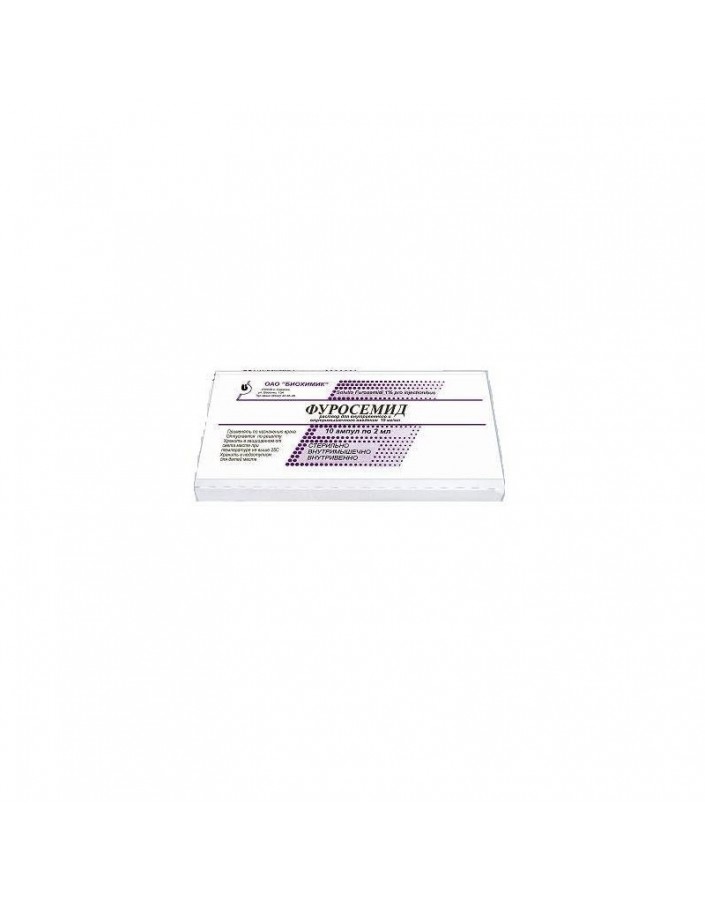




Security policy (edit with Customer reassurance module)

Delivery policy (edit with Customer reassurance module)

Return policy (edit with Customer reassurance module)
Injection
1 ml contains furosemide 10 mg
10 ampoules of 2 ml.
Furosemide is a potent diuretic with a rapidly developing effect. Violates the reabsorption of sodium ions, chlorine in a thick segment of the ascending part of the loop of Henle. In addition, increases the excretion of ions of potassium, Calcium, Magnesium.
- edematous syndrome of various genesis, including in chronic heart failure stage IIB-III, liver cirrhosis (portal hypertension syndrome), nephrotic syndrome;
- pulmonary edema;
- post-traumatic brain edema;
- some forms of hypertensive crisis;
- eclampsia;
- premenstrual tension syndrome;
- the program of forced diuresis in case of poisoning with barbiturates.
- renal failure with anuria;
- hepatic coma and precoma;
- violations of water-salt metabolism: hypokalemia, hyponatremia, hypovolemia (including hypotension) or dehydration;
- I and II trimesters of pregnancy;
- hypersensitivity to sulfonamides.
Furosemide is contraindicated for use in the I and II trimesters of pregnancy.In the third trimester, its use is possible only under strict indications and for a short period.
If necessary, the use of furosemide during lactation should stop breastfeeding due to the fact that furosemide is excreted in breast milk and suppresses lactation.
Furosemide is prescribed intravenously and intramuscularly. For adults, the daily dose for parenteral administration is 40–60–120 mg (1–2 times a day). The maximum daily intake for adults is 240 mg. For children, the initial daily dose is 1 mg per kg of body weight, the maximum daily dose is 6 mg per kg of body weight.
With caution, the drug is prescribed for severe cardiovascular insufficiency, with prolonged therapy with cardiac glycosides, as well as in elderly patients with severe atherosclerosis. Prior to treatment, serious disturbances in water and electrolyte balance should be compensated.
Control of laboratory parameters
During treatment, the level of electrolytes, carbonates, urea should be regularly monitored (especially when using doses higher than 80 mg).
Influence on ability to drive motor transport and control mechanisms
The question of the possibility of practicing potentially hazardous activities that require increased attention and quickness of psychomotor reactions should be addressed after evaluating the patient's individual response, in connection with a possible decrease in the ability to concentrate.
With the simultaneous use of furosemide with cardiac glycosides increases the risk of glycoside intoxication, and when combined with the use of GCS - the risk of hypokalemia.
With simultaneous use of furosemide potentiates the action of muscle relaxants.
With simultaneous use of furosemide with aminoglycosides or cephalosporins and Cisplatin, their plasma concentrations may increase, which may lead to the development of nephro and ototoxic effects.
With simultaneous use of NSAIDs can reduce the diuretic effect of furosemide.
With simultaneous use of furosemide and antihypertensive drugs hypotensive effect is potentiated.
With simultaneous use with furosemide, the action of hypoglycemic drugs and pressor amines can be weakened.
Symptoms: dehydration, reduction of BCC, arterial hypotension, disturbances of water and electrolyte balance, hypokalemia and hypochloremic alkalosis due to diuretic effect.
Treatment: conduct symptomatic therapy. There is no specific antidote.
The drug should be stored in a dry, dark place at temperatures not above 25 ° C.
2 years.